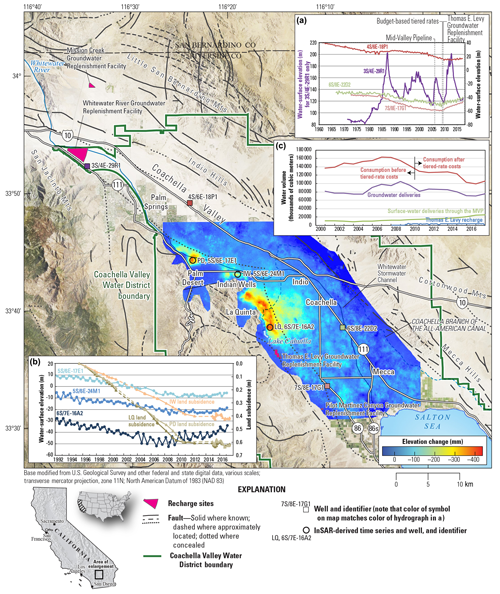Mitigating Land Subsidence in the Coachella Valley, California, USA: An Emerging Success Story
Groundwater has been a major source of agricultural, municipal, and domestic water supply since the early 1920s in the Coachella Valley, California, USA. Land subsidence, resulting from aquifer-system compaction and groundwater-level declines, has been a concern of the Coachella Valley Water District (CVWD) since the mid-1990s. As a result, the CVWD has implemented several projects to address groundwater overdraft that fall under three categories – groundwater substitution, conservation, and managed aquifer-recharge (MAR). The implementation of three projects in particular – replacing groundwater extraction with surface water from the Colorado River and recycled water (Mid-Valley Pipeline project), reducing water usage by tiered-rate costs, and increasing groundwater recharge at the Thomas E. Levy Groundwater Replenishment Facility – are potentially linked to markedly improved groundwater levels and subsidence conditions, including in some of the historically most overdrafted areas in the southern Coachella Valley. Groundwater-level and subsidence monitoring have tracked the effect these projects have had on the aquifer system. Prior to about 2010, water levels persistently declined, and some had reached historically low levels by 2010. Since about 2010, however, groundwater levels have stabilized or partially recovered, and subsidence has stopped or slowed substantially almost everywhere it previously had been observed; uplift was observed in some areas. Furthermore, results of Interferometric Synthetic Aperture Radar analyses for 1995–2017 indicate that as much as about 0.6 m of subsidence occurred; nearly all of which occurred prior to 2010. Continued monitoring of water levels and subsidence is necessary to inform the CVWD about future mitigation measures. The water management strategies implemented by the CVWD can inform managers of other overdrafted and subsidence-prone basins as they seek solutions to reduce overdraft and subsidence.






